Staying connected while exploring remote destinations used to mean relying on sketchy cell service or carrying a bulky satellite phone. On my recent off-the-grid adventure in my Tesla Model Y to the Arctic Ocean, I needed a more reliable option.
On top of range anxiety and the fear of flat tires on the infamous Dempster Highway, safety was my top concern. That’s where a Tesla Starlink install came in handy. Combining the speed of Starlink internet with the practicality of a Tesla setup gave me connectivity and peace of mind on one of the most challenging road trips in North America.
In this post, I’ll cover my Tesla Starlink install and setup along with everything you need for the best connectivity on the go—so you can stay safe, connected, and confident even in the most remote places.
Key Takeaway: With the right Starlink setup in your Tesla, you can turn even the most remote and rugged drives into connected adventures without sacrificing safety or convenience.
What Is Starlink and How Does It Work?
Starlink is SpaceX’s satellite internet service that uses low Earth orbit satellites to provide broadband internet almost anywhere on the planet. Unlike traditional satellite services, which orbit much farther away, Starlink’s satellites sit closer to Earth, meaning lower latency and much faster speeds.

For remote travelers, this is a game-changer. Instead of relying on weak or nonexistent cell service, Starlink lets you stream, video call, and navigate as if you were at home. In many ways, Tesla Starlink internet is the perfect pairing for EV drivers taking long and isolated routes.
When I made my plan to drive an electric vehicle to the Arctic Ocean, I knew having Starlink would be essential.
Starlink Subscription Options
Starlink offers several subscription tiers. For travelers, the most useful ones are:
- Standard (Residential) — $120 USD/mo (US) / $140 CAD/mo (Canada). Fixed service address (not ideal for travel).
- Roam — 50GB — $50 USD/mo (US) / $70 CAD/mo (Canada). Occasional use; you can buy extra data by the GB.
- Roam — Unlimited — $165 USD/mo (US) / $189 CAD/mo (Canada). Portable use with international travel in 100+ markets.
- Maritime & Mobility (Business tiers) — higher cost for ships/RVs and in-motion reliability; example Canada pricing for Global Priority starts at $365 CAD/mo for 50GB, with higher tiers available.
For my Arctic adventure, the Roam Regional plan worked perfectly. However, data isn’t unlimited—after 50GB, I needed to top up. I purchased an extra 50GB for $36 CAD, and by the end of my two-plus-week trip, I had used about 75GB.
For comparison, the average North American household uses more than 500GB a month, so this was a lean but workable amount for travel.
What You Need for a Tesla Starlink Install
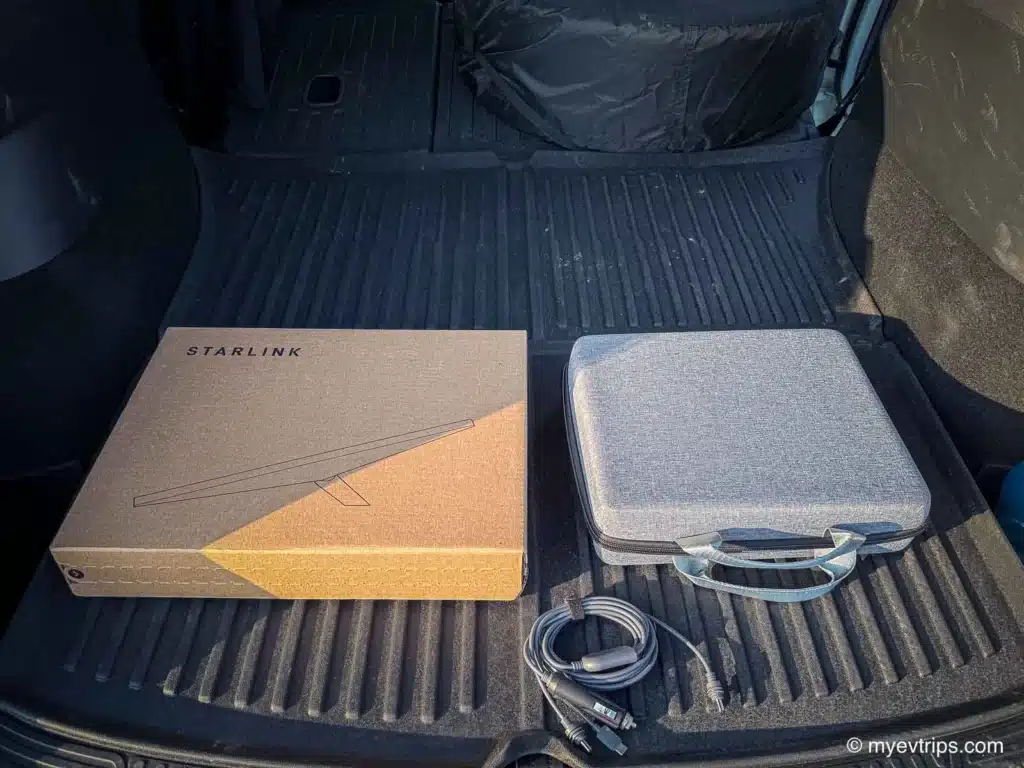
Installing Starlink in a Tesla isn’t complicated, but it does require some additional gear to make it functional and tidy. Here’s what I used for my optianal Starlink dish install in my Tesla Model Y that kept everything out of site and easy to operate:
- Starlink Mini – compact and perfect for travel.
- Suction Cup Roof Mount – to secure the dish neatly on the glass roof.
- Starlink USB-C Splitter & AC Adapter Splitter – for powering options.
- Anker C300 Battery Pack – portable power source that kept Starlink running 8–10 hours.
- Anker AC Charge Cable – to charge battery pack from car AC port.
- Starlink Mini Case – for storage when not in use. Fits out-of-sight under driver seat.
- Plastic Pry Tool – to run and conceal cabling through the car interior.
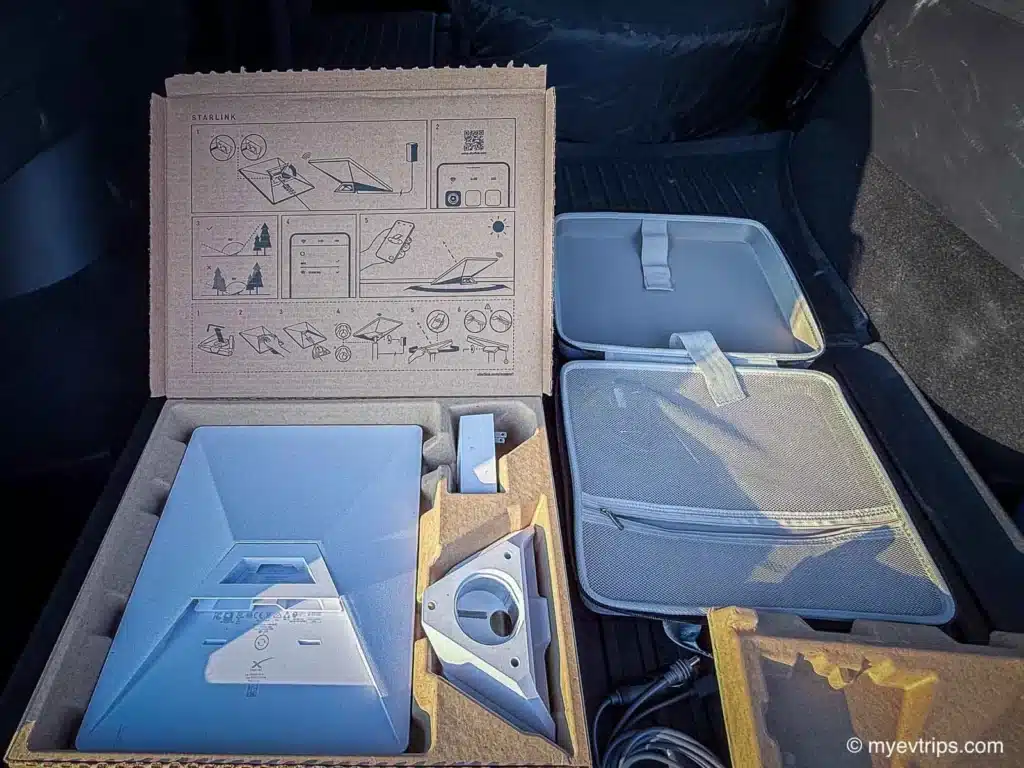
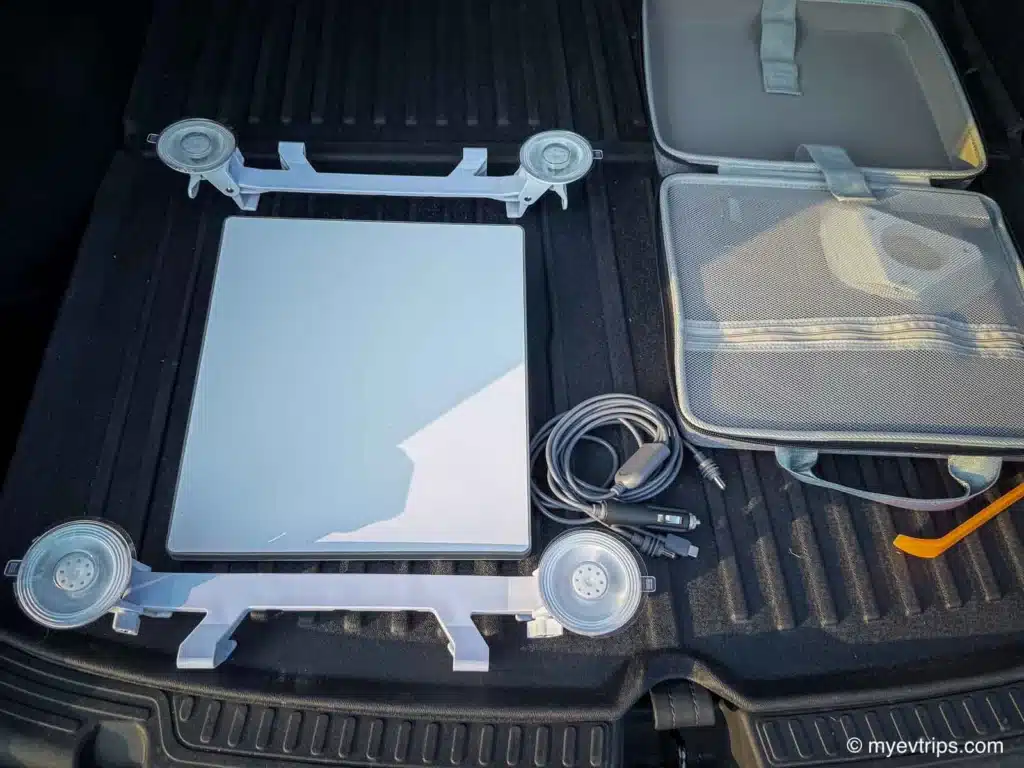
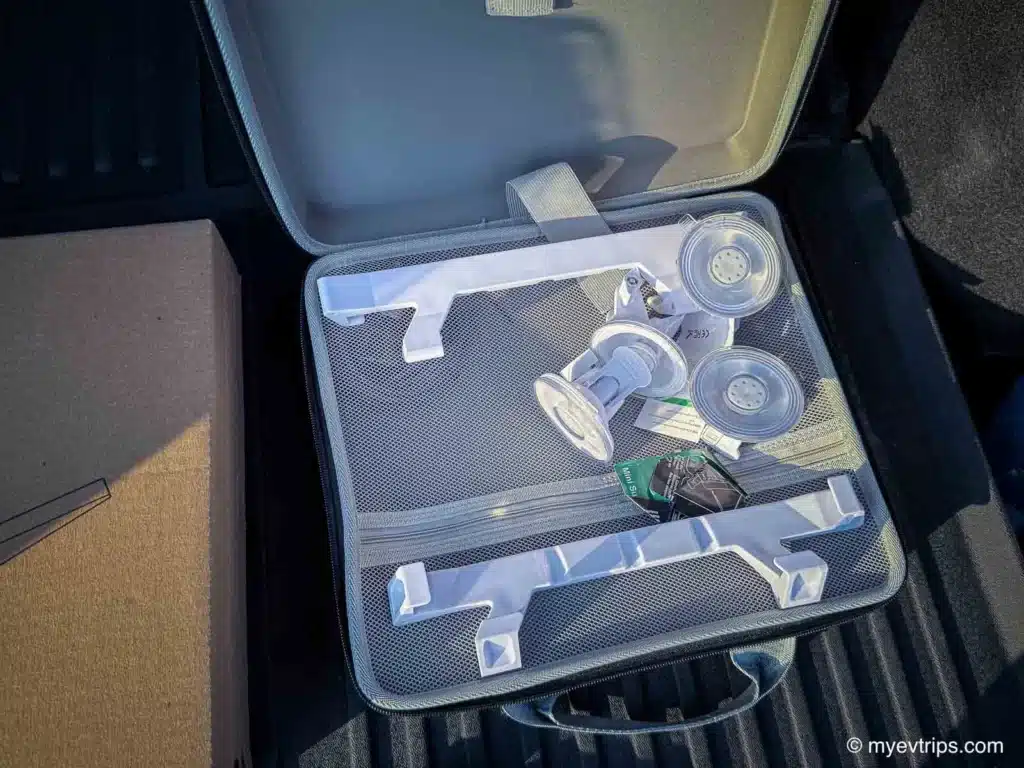
Starlink battery Pack
Starlink requires a 100W USB-C port to run—something my Tesla Model Y doesn’t have. More importantly, running it directly from the car risks unnecessary battery drain on long, remote stretches like the Dempster Highway, where conserving every kilometer of range matters. That’s why a dedicated battery pack is essential.
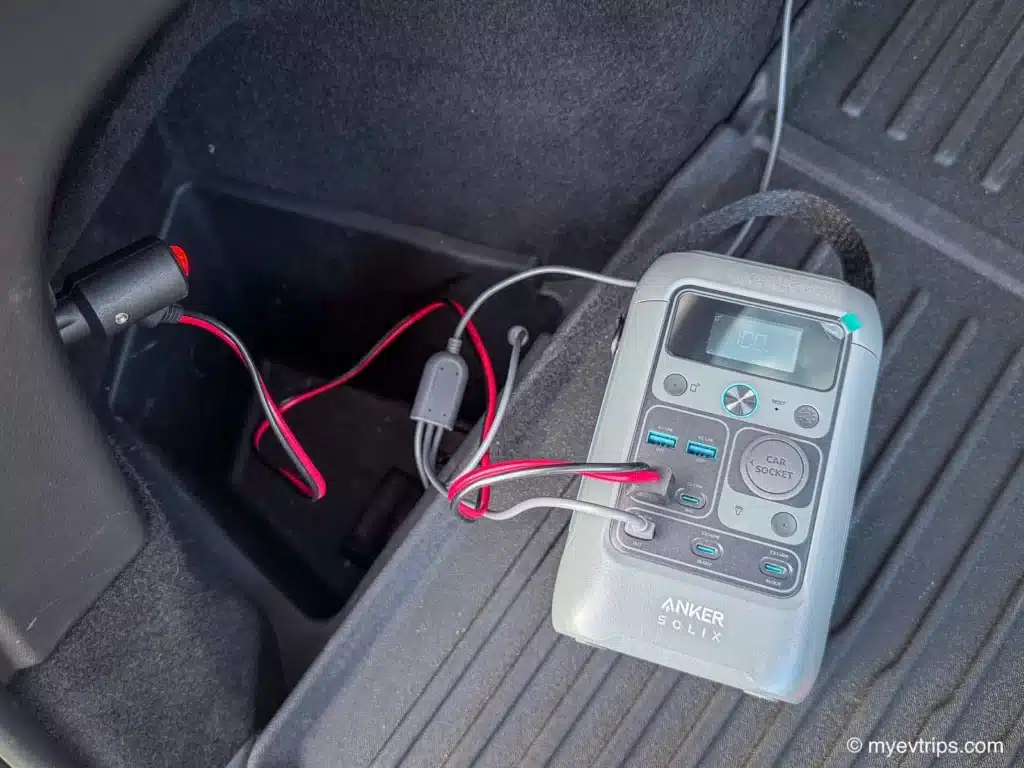
In my setup, I used the Anker C300 DC, which I connected to the car’s 12V cigarette lighter outlet via a kill switch. I’d switch it on while charging the Tesla or once parked for the night, letting the pack recharge without cutting into driving range. When it was time to use Starlink, I could power it straight from the battery pack and stay connected without worry.
I debated between the Anker C300 DC and the standard Anker C300. Both are 288Wh, but the differences matter:
- Anker C300 DC: Lighter, more compact, includes a built-in camp light, perfect for packing light.
- Anker C300: Slightly bulkier but includes 3x 120V AC outlets, can charge via AC, and doubles as a UPS for continuous power.
While the C300 DC kept my setup minimal, the Anker C300 would have been far more versatile. Even though both last about the same, the C300’s AC outlets make it better suited for powering multiple devices, appliances, or camping gear.
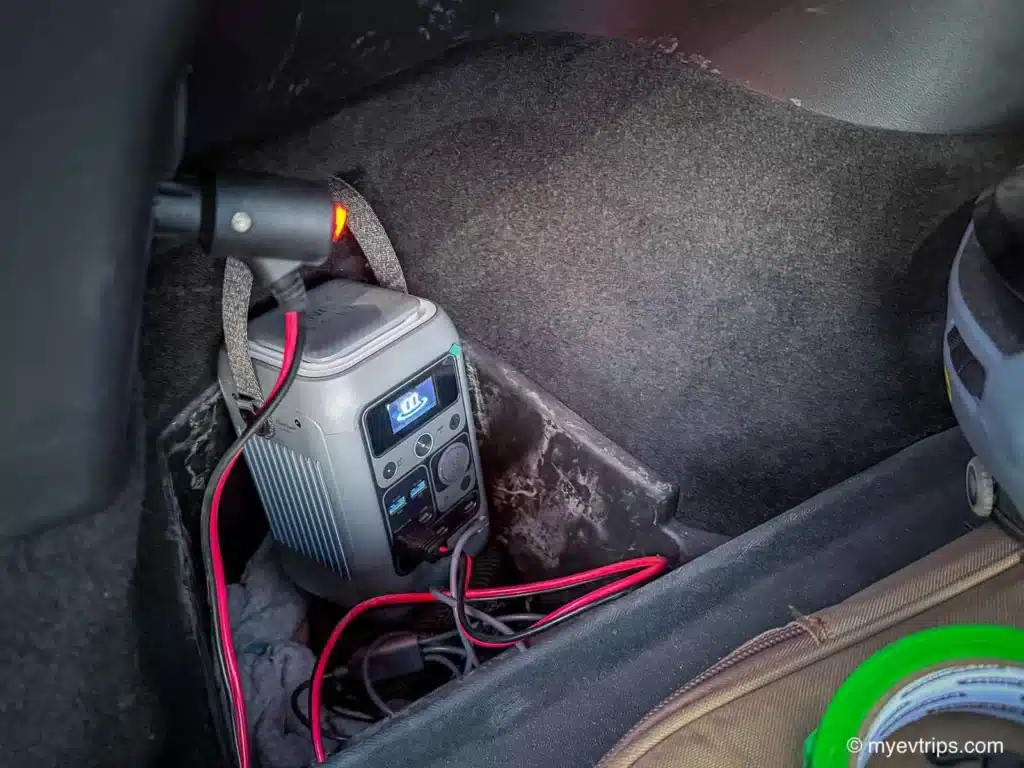
If I were to do this again, I’d recommend going with the Anker C300—it would pair perfectly with the best car camping accessories I bring along, like compact stoves and portable fridges, while still being small enough to tuck into the Tesla’s wheel well.
@myevtrips My Tesla camping kit now comes with WiFi 🌲🚗💨 Here’s everything you need to install Starlink in your Tesla: ✅ Starlink Mini ✅ Suction Cup Roof Mount ✅ 3-in-1 Power Cable ✅ Battery Backup ✅ Storage Case This setup was key to keeping me safe and connected while driving the remote Dempster Highway all the way to the Arctic Ocean and will be taking it with me on all future road trips. ❄️ Want the full step-by-step guide (with links to each item)? 👉 Head to myevtrips.com for all the details. #TeslaCamping #Starlink #EVLife #StarlinkMini #Overlanding ♬ Whatcha Gonna Do – The Valdons
How to Install Starlink in a Tesla
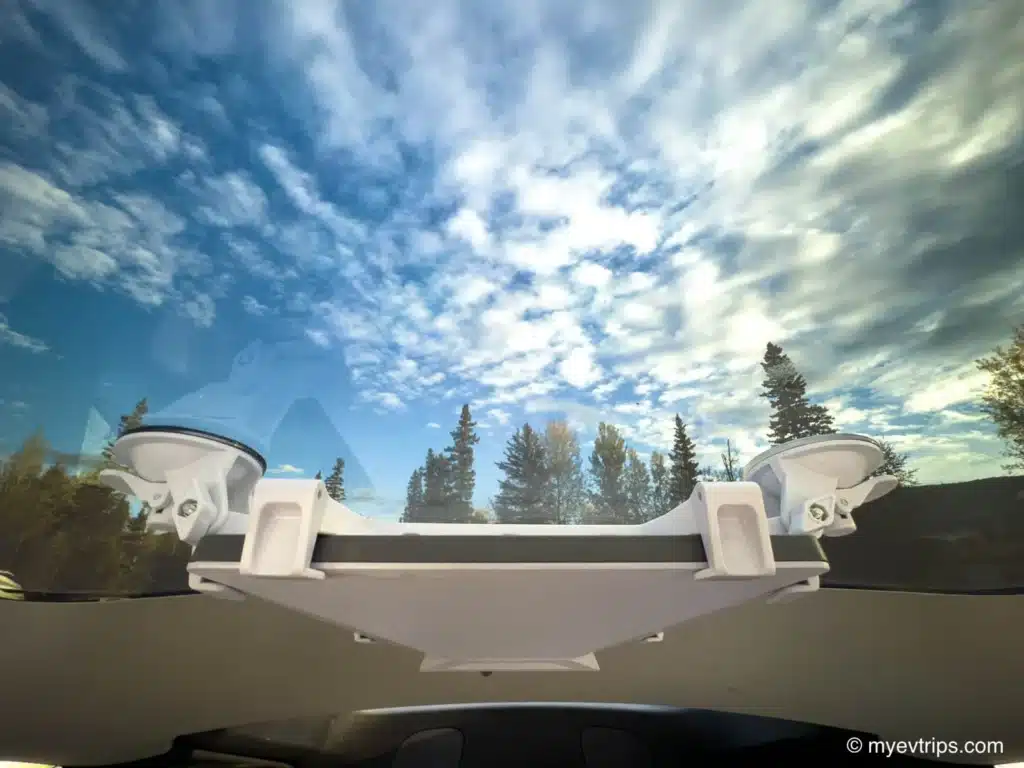
Here’s how I completed my Tesla Starlink roof install:
- Run the cabling: I started by threading the Starlink cable through the back hatch, using a pry tool to tuck it into the side panels. This kept everything neat and hidden.
- Position the battery: I placed the Anker battery pack in the driver side trunk wheel well where the cigarette plug is located. There it could charge and power Starlink via its high-wattage ports. This way, I wasn’t draining my Tesla’s main battery.
- Set the roof mount: With the suction cup mount, I secured the Starlink dish to the back section of the glass roof. The fit was sleek and stable—even on the rough roads of the Dempster Highway.
- Connect the adapters: The AC adapter and splitter ensured clean connections, while allowing me to recharge the Anker pack overnight at charging stops.
- Test the system: Once everything was in place, I powered up the dish. It connected within minutes and gave me speeds of 50–100 Mbps—plenty for streaming, video calls, and navigation.
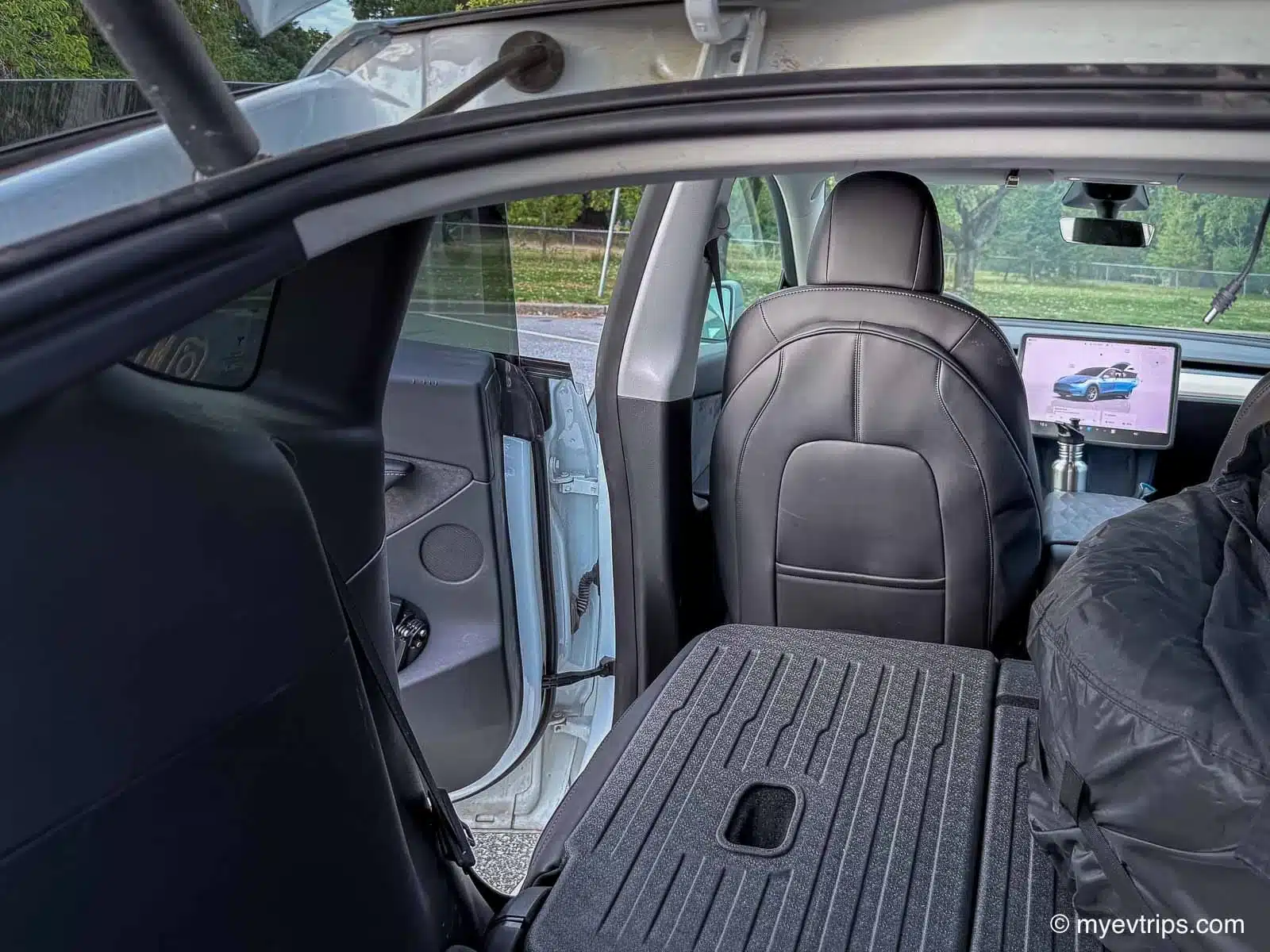
The whole Starlink roof mount process took under 30 minutes and looked surprisingly clean. With Tesla’s all-glass roof, it blended in nicely without bulky mounts or brackets sticking out. It’s one of the best ways to protect your Tesla’s sleek design while still adding practical off-grid connectivity.
NOTE: As per a Tesla Facebook group member, Kenny Wei, the reflective roof coating on some newer Teslas does not work with Starlink. He had to install his mount on the trunk hatch window in his refreshed 2025 Tesla Model Y.
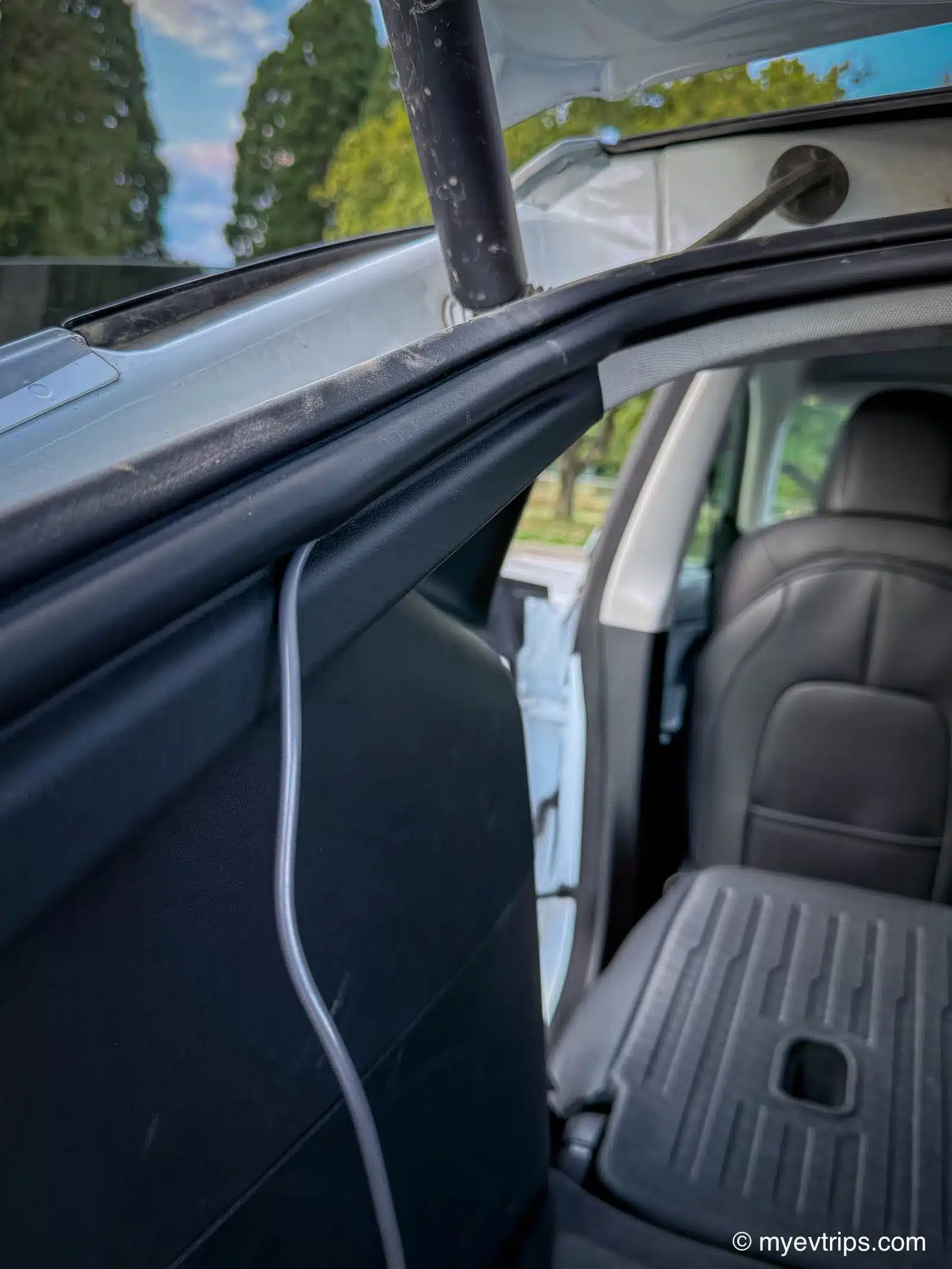
When not in use, the dish and starlink roof mount fits in the Starlink mini case I bought and tucks away neatly under the driver seat.
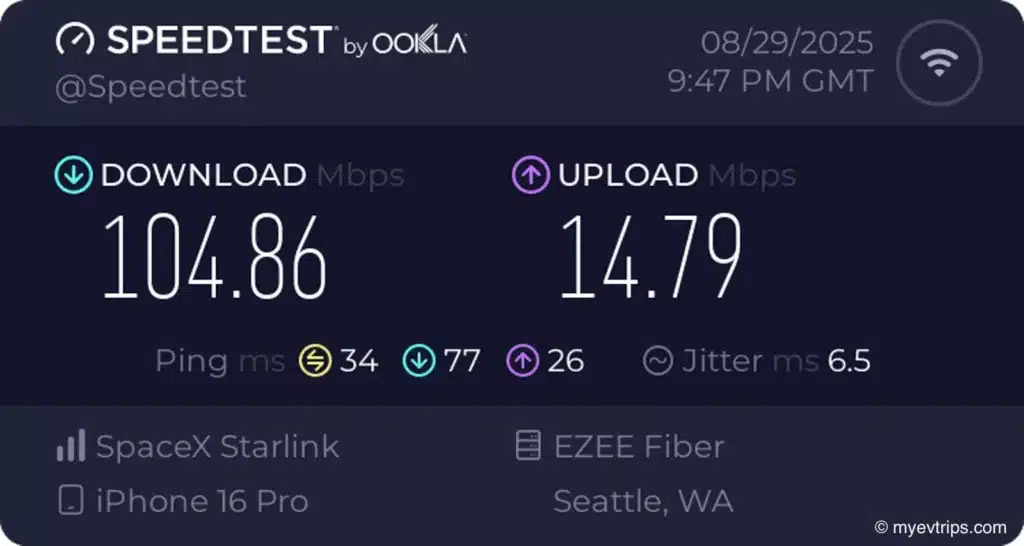
Real-World Results: Dempster Highway and Beyond
The Dempster Highway stretches 740km (460 miles) from Dawson City, Yukon, to Inuvik, Northwest Territories, and continues to the Arctic Ocean. It’s a notoriously rough road—flat tires are common, and services are scarce. Having Starlink made all the difference.
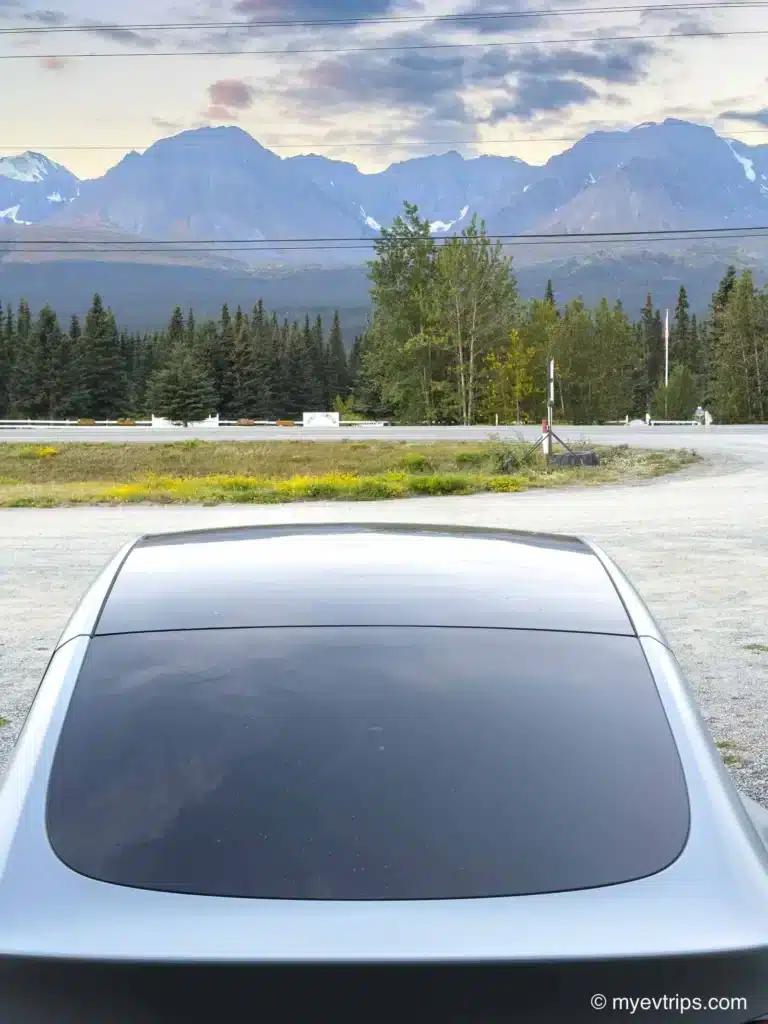
When I blew a couple of tires, I was able to immediately message my travel companion, who was hours ahead in an internal combustion vehicle. Without Starlink internet, he might have turned back unnecessarily or worried about my safety. Instead, he could coordinate help if needed. This was one of the big reasons I felt confident attempting an EV road trip all along the Dempster Highway in the first place.
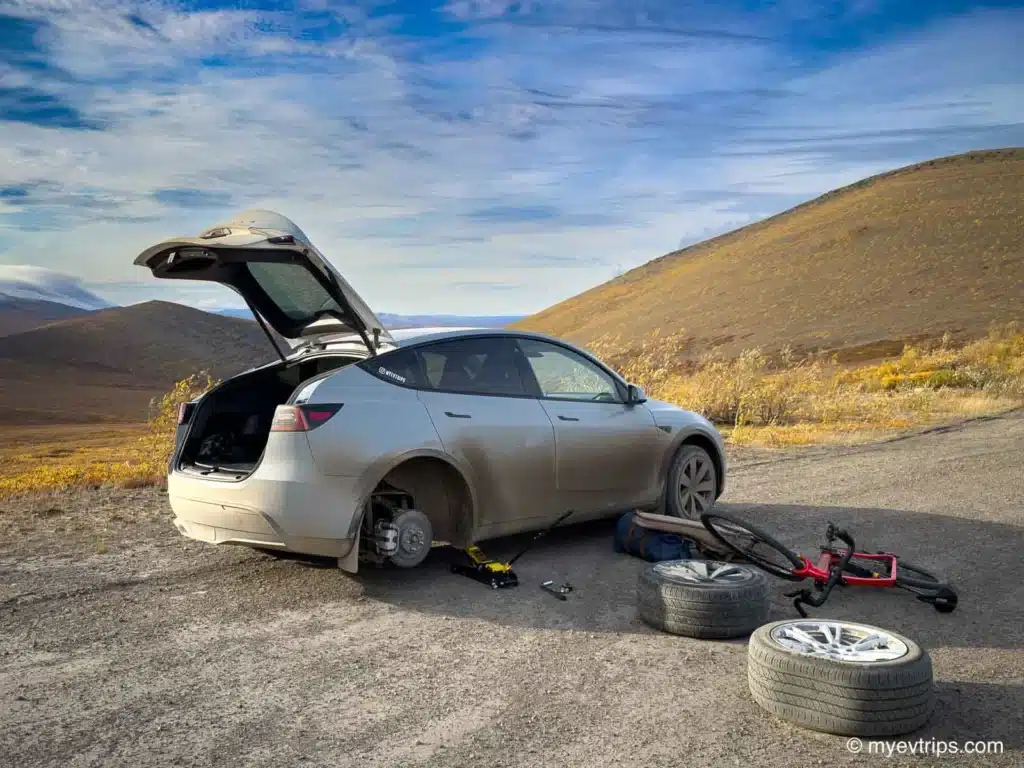
Beyond emergencies, Starlink was just plain fun. I streamed podcasts while driving, video-called family from campsites, and even FaceTimed my mother from the edge of the Arctic Ocean. Those moments were surreal—having reliable internet in a place where most people barely have radio service.

Data usage was my only real limitation. Streaming ate through the 50GB quickly, and I needed to top up. Still, the convenience was worth every penny.
I also tested Starlink on the Alaska Marine Highway ferry from Bellingham to Juneau. I had planned to use it in my cabin, but to my surprise, the ferry was trialing onboard internet. It worked well enough that I didn’t need my setup, but Starlink gave me backup peace of mind.
This test gave me confidence for future remote road trips, such as driving to Yellowknife, where cell coverage is limited, and for bucket-list plans like taking an electric vehicle to Saint Pierre and Miquelon France.
Why You Should Consider Starlink for Your Tesla
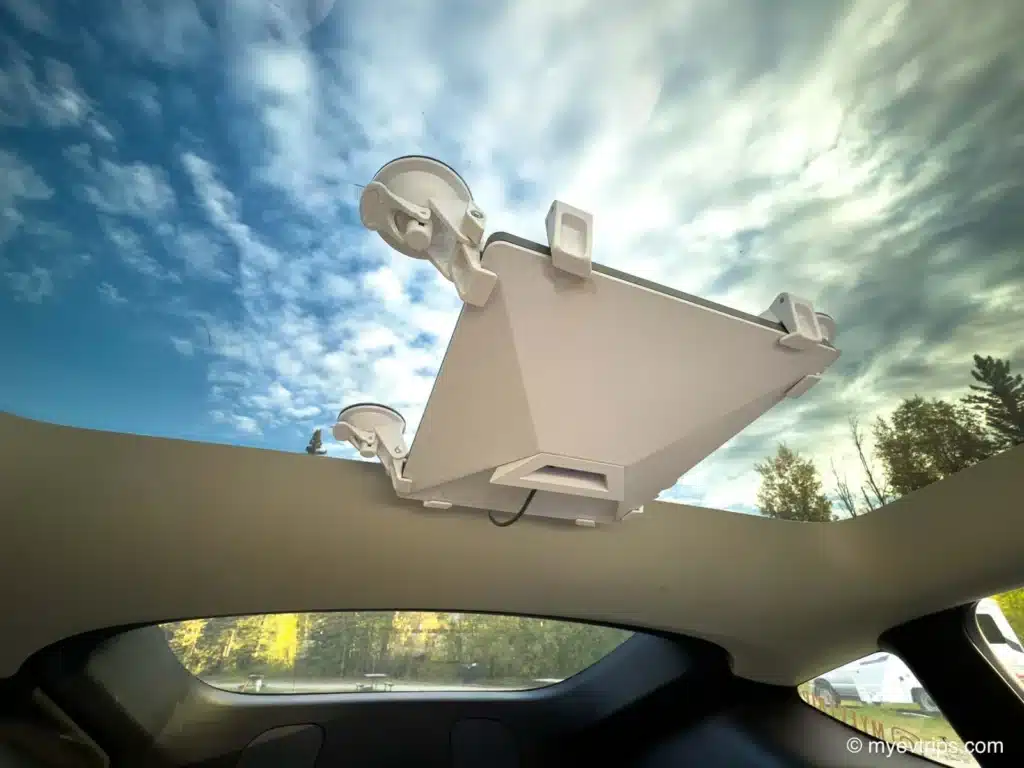
Traveling in remote regions comes with risks. Whether it’s tire damage, range anxiety, or weather delays, having Tesla Starlink internet gives you a lifeline. During my trip, I noticed plenty of northern trucks with dishes mounted outside or propped in windshields. But with Tesla’s glass roof and a suction mount, the system is cleaner, stealthier, and more efficient.
For road trippers and EV adventurers, the benefits go beyond safety:
- Stay in touch with family and friends.
- Stream entertainment on long drives.
- Work remotely from virtually anywhere.
- Use navigation and maps without worrying about service dead zones.
For me, it also fit in nicely with my existing storage accessories for the Tesla Model Y, including hidden compartments where I could stash cables and keep the interior tidy. It’s another example of how thoughtful gear can make EV travel smoother.
At night, I found myself camping out with Starlink running, tucked into the car with one of the best beds to use in your Tesla, enjoying a mix of comfort and connectivity. Pairing that with the best floor mats for a Tesla Model Y to keep things clean after muddy roadside stops made the experience even better.
Is Tesla starlink internet Install Worth it?
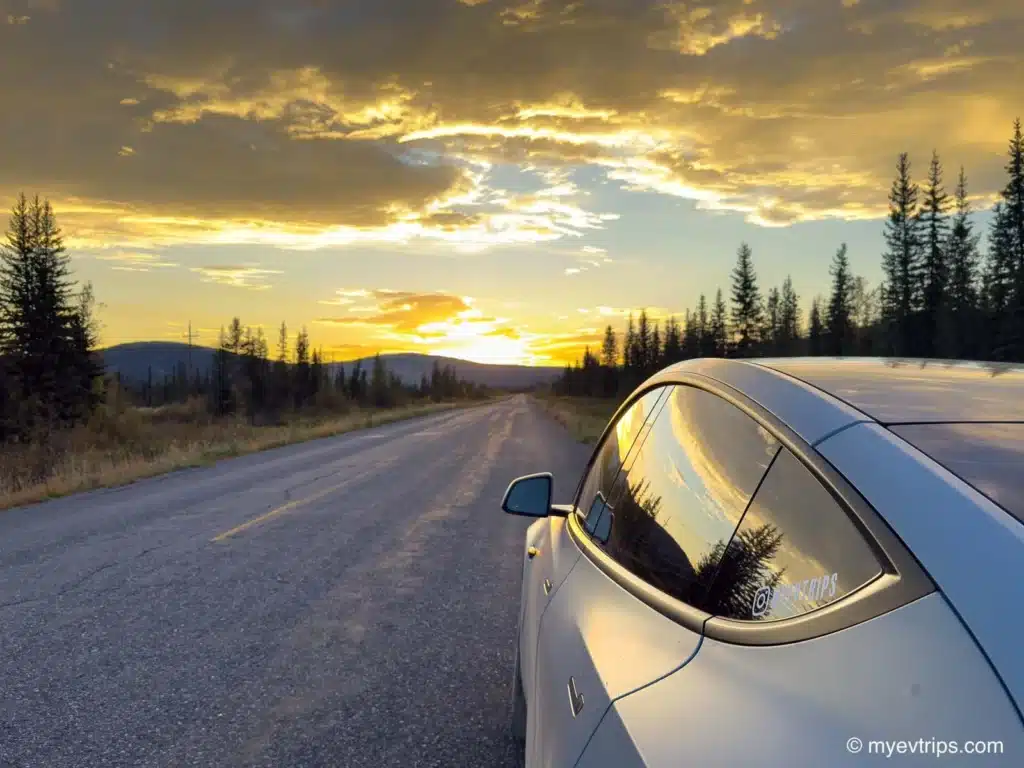
For me, adding Starlink to my Tesla Model Y was about safety and peace of mind—but it quickly became about freedom and fun. Whether calling for help after a flat tire, streaming Netflix under the northern lights, or video calling from the Arctic Ocean, this Tesla Starlink install delivered.
With the right gear—Starlink dish install, suction cup roof mount, and a battery pack—you can bring full-blown internet anywhere your Tesla takes you. If you’re planning driving an EV through the Yukon or another remote adventure, it’s one of the smartest investments you can make.
FAQ: Tesla Starlink Install
Can you use Starlink while driving?
Yes, but speeds and stability vary. On the Dempster Highway, it worked consistently enough for streaming and calls.
Does Starlink drain your Tesla’s battery?
Not if you use an external battery pack like the Anker 300. This preserves driving range.
How fast is Starlink on the road?
I saw speeds between 50–100 Mbps, enough for video calls and streaming.
Is Starlink worth it for Tesla owners?
If you travel in remote areas, absolutely. It’s safer, more reliable, and more versatile than a satellite phone.
- READ MORE: The Best Tesla Model Y Floor Mats Compared

SAVE ON A NEW TESLA!
Thinking of buying a Tesla? Use this referral link to get up to $1,300 off!*
*As of August 2024, Tesla has reinstated its referral program and introduced attractive financing options!


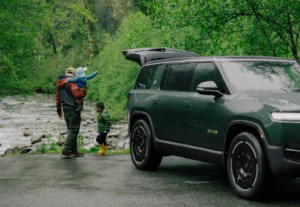

Pingback: Alaska Ferry Travel Guide: AMHS Cabins, Camping & Costs